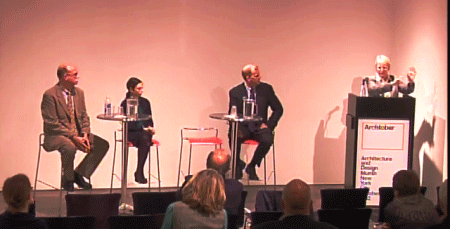by: Jerry Maltz AIA and Lorraine Hiatt Ph.D.
Event: Total Design Approaches for Senior Living in Urban Environments: Green House and Small House
Location: Center for Architecture, 10.10.12
Speakers: Rachel Fredman, Community Liaison, Jewish Home Lifecare; David Hoglund, FAIA, Principal, Perkins Eastman; Timothy Barnhill, AIA, LEED AP, Principal, Hord Coplan Macht
Moderator: Lorraine Hiatt, Ph.D., Environmental Gerontologist
Organizer: AIANY Design for Aging Committee
The Green House® and Small House models for the design of living facilities for seniors are rather new. These are person-centered approaches to senior care, with a vision of balancing needed physical care with concerns for social life, privacy, and dignity, reinforced through staffing and design. They offer additional choices for older adults needing skilled and long-term care by providing 24-hour licensed nursing care as in the traditional nursing home, but in an atmosphere that closely resembles a residential environment, with a trained team of caregivers dedicated and assigned to the total needs of the residents. In the process of designing both Small Houses and Green Houses, David Hoglund, FAIA, indicated that he has learned much about how significantly the physical environment can affect people’s lives. This is particularly true for seniors, whose physical capabilities tend to become more limited with age.
The first Small House opened in New Jersey in 2001; the first Green House opened in Mississippi in 2005. “Green House” is a trademarked organization fouonded by Dr. Bill Thomas, with a protocol that outlines both the relationships between seniors and caregivers, and household design elements to be included to maintain a residential atmosphere. The Green House organization offers project development consultation services and staff training, for which sites pay annual fees. As they have received feedback from operating Green Houses, it has modified some of the regulations over time. There are about 200 Green Houses now functioning around the U.S. (of 16,000+ licensed nursing homes). But the idea has also stimulated the development of variations and Small Houses, which are dedicated to the same person-centered care, but innovate to satisfy specific local conditions.
Perkins Eastman is designing an Upper West Side high-rise to extend the values of Small House design to an urban population of 414 residents. The plan is organized into households (essentially, large apartments), two per floor for 12 residents each. The units consist of a private bedroom and bathroom for each resident, a living room, dining room, an open kitchen where residents can help in preparing their meals if they wish, and an all-season screened “porch.” The furniture is movable rather than built in, so it can be arranged as each household chooses, and residents can personalize their bedrooms with some items of their own. Caregiving roles are being redefined to accommodate residents’ total physical and social needs. The lower floors of the building contain shared destinations: community rooms, a library, exercise/therapy rooms, spaces for social services and medical care, and an outdoor garden.
Rachel Fredman explained that Jewish Home Lifecare, the client for the Manhattan Green House, is an organization that has served the needs of seniors on the Upper West Side for well over 150 years. In their new facility they aim to keep the elders as active and independent as possible, including participation in decision-making about the operation of their households, and maintaining meaningful relationships with families and staff. The seniors become an integral part of the power structure, and are expected to thrive in that role.
Tim Barnhill, AIA, LEED AP, spoke about the Levindale Small House that he designed in Baltimore. For economic reasons, it is organized into households of 14 residents each (12 is the maximum permitted in the Green House model). There are three resident floors (“neighborhoods”), each containing two houses, each with its own front door, open kitchen, private bedrooms and baths, with libraries and laundry rooms that function very similarly to the households of the Green House. The facility was designed with much attention devoted to the resident rooms, including full-scale mockups of the bathrooms that were extensively tested to determine many of the details. Each house is designed compactly, with concern for the distances the residents and caregivers are required to travel from bedroom to dining room, and to other parts of the house. A Town Center on the ground floor contains common spaces: a synagogue, café and pub, gift shop, rotating art exhibit, spaces for social services and medical specialists, and an outdoor garden. Levindale’s residential scale relates well to that of the surrounding residential community.
These facilities provide significant new and improved options for senior living. Many Small Houses and Green Houses are being built on existing health-care campuses, where shared common areas offer advantages to new and established residents. And there are likely to be further innovations in the near future: scattered-site Small Houses and Green Houses; co-housing for seniors; elder-friendly cooperatives; elders and intentional intergenerational communities; and urban aging-in-place.
For more information about Green Houses and Small Houses visit the AIANY Design for Aging Committee website.
Jerry Maltz, AIA, is Co-Chair of the AIANY Design for Aging Committee. Lorraine Hiatt, Ph.D., is an Environmental Gerontologist who does planning, research, and design consultation.








